Network connection is influenced by a number factors: network delay, queuing delay in middle boxes, network jitter, packet loss, packet re-ordering and even packet duplication. In this post we speak about the network jitter.
What’s Network Jitter
Network jitter is a measure of variation of arrivals times of packets to Receiver, it’s desirable that Sender sends packets uniformly, equally spaced time intervals, otherwise the network jitter is noised. In other words the network jitter of a packet is the difference between the actual arrival time and the expected one. If the difference is greater 0 then the packet has arrived Receiver lately (and can be discarded if it arrived too lately). If the difference is negative then the packet arrived early and Receiver should have sufficiently large playout buffer to amortize the jitter.
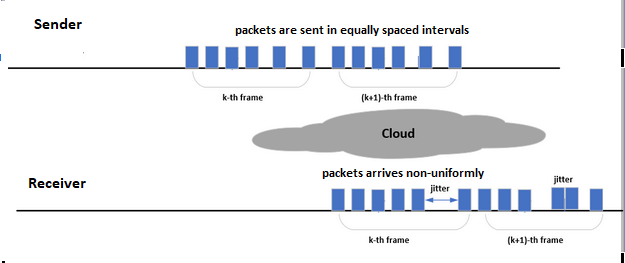
Large network jitter requires large amortization buffer at Receiver and consequently additional latency added. Cloud gaming and video conferencing applications are very sensitive to the latency. If the network jitter is smaller than the frame duration (1/fps) then an input buffer is sufficient to accumulate a single frame, otherwise the amortization buffer is needed.
Instantaneous changes in arrival times of packets that exceed the jitter amortization buffer result in overruns (Receiver discards input packets since there is no room to absorb them) or underruns (Receiver should decode and display a frame, but the frame has not completely arrived or the buffer is empty. In such case Receiver can wait until the frame completed but it might produce visible stuttering and even lip-syncs).
The amortization buffer at Receiver can be adaptive according to measured network jitter: larger jitter larger buffer and vice versa.
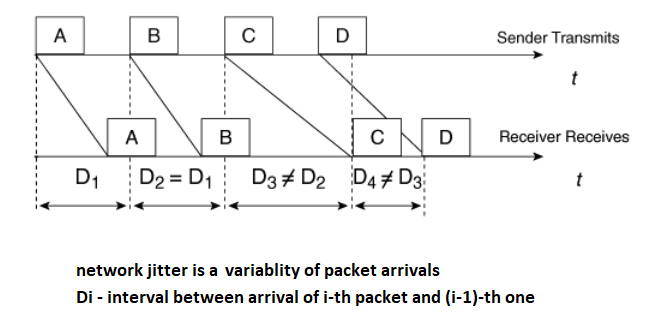
the figure is taken from the book “End-to-End QoS Network Design Quality of Service for Rich-Media & Cloud Networks”, Tim Szigeti et al. , 2014
How to Estimate Jitter
Let’s assume that Sender sends RTP-packets, each RTP packet carries its own delivery timestamp (usually in units of ms). RTP packetization is popular in media streaming.
Protocol stack of delivered media (MPEG2 System or Transport Stream is optional and not recommended, this layer adds ~2% of overhead):
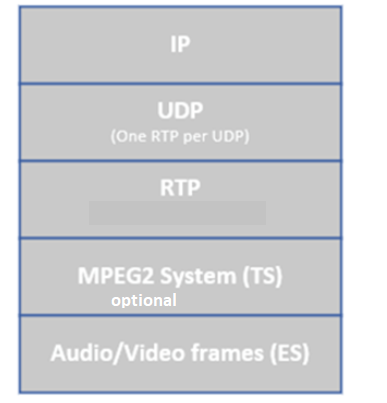
Timestamps are conveyed in RTP layer, we show below that the timestamps are necessary to estimate the network jitter.
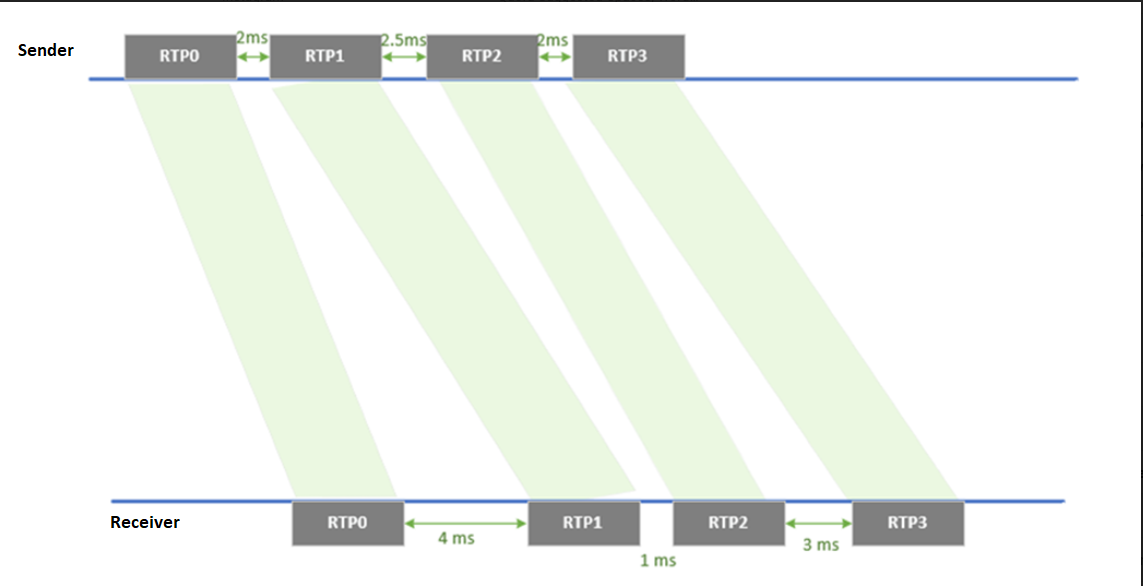
Denote the deviation D(i) of inter-arrival times of successive packets i-th and (i+1)-th:
D(i) = (R(i+1) – R(i)) – (S(i+1)-S(i)) (1)
Where R(i) is the timestamp in RTP header of i-th packet (at Sender’s clock), S(i) is arrival time of i-th packet to Receiver (at Receiver’s clock).
It’s obvious from the formula (1) that if the network jitter is zero then D(i) = 0.
The network jitter J can be progressively updated as follows:
for the very first packet J = |D(0)|
for non-first packet ‘i’:
J = J + 1/16( | D(i) | – J )
The 1/16 is the reactive factor, you can take 1/32 or 1/8.
Conclusion: The larger jitter the larger playout buffer at Receiver’s side.
Mismatches between the network jitter and the playout buffer can cause annoying effects like jerkiness in playback due to the failure of some frames to meet their presentation deadlines (the frame arrives too late or the frame arrives too early and the playout buffer is full).
Few of Experimental Data
According to the work “RTP: Audio and Video for the Internet” by Colin Perkins the network jitter is not distributed normally, the distribution is right-tailed:
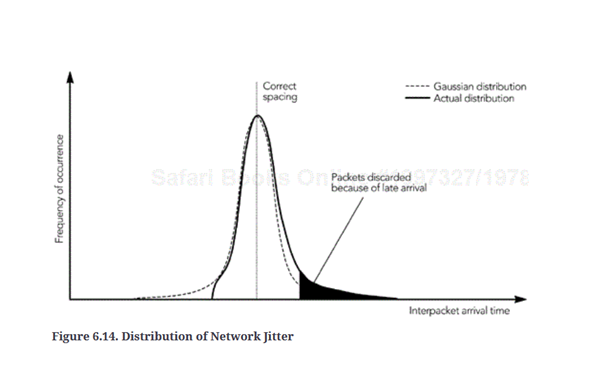
In such case STD makes few sense, for example we can’t use the rule of 3-sigmas (only in the normal distribution the probability of deviation from 3-sigmas is less 1%). In the case of skewed asymmetrical distribution the STD is replaced with other parameter called ‘skewness’:

Another definition of the skewness:
3(mean – median)/σ
or even
(mean – median)/σ

23+ years’ programming and theoretical experience in the computer science fields such as video compression, media streaming and artificial intelligence (co-author of several papers and patents).
the author is looking for new job, my resume



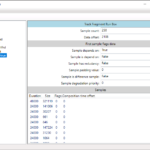


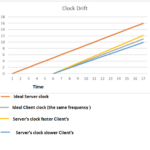
Hello, i feel that i saw you visited my weblog thus i got here to “return the choose”.I am attempting to in finding things to improve my web site!I guess its adequate to make use of a few of your ideas!!
After research a few of the weblog posts in your web site now, and I actually like your approach of blogging. I bookmarked it to my bookmark web site checklist and can be checking again soon. Pls check out my website online as well and let me know what you think.
Wohh precisely what I was searching for, regards for putting up.
Youre so cool! I dont suppose Ive read something like this before. So good to search out somebody with some authentic ideas on this subject. realy thank you for beginning this up. this web site is something that is needed on the web, someone with just a little originality. helpful job for bringing one thing new to the web!
Whats up very cool website!! Guy .. Beautiful .. Wonderful .. I will bookmark your web site and take the feeds additionally…I am happy to find numerous helpful info here in the put up, we’d like work out more techniques on this regard, thanks for sharing.
But wanna remark that you have a very decent web site, I enjoy the design and style it really stands out.
You are my inspiration , I have few blogs and sometimes run out from to post : (.
Hey there! This is kind of off topic but I need some advice from an established blog. Is it difficult to set up your own blog? I’m not very techincal but I can figure things out pretty fast. I’m thinking about setting up my own but I’m not sure where to start. Do you have any points or suggestions? Many thanks
you are welcome to speak to our web-designer Ivan Lukin vanyalukin007@gmail.com, i am responsible for the content, he is responsible for the form
I have been reading out a few of your posts and i can state pretty nice stuff. I will surely bookmark your website.
Hey There. I found your blog using msn. This is an extremely well written article. I will be sure to bookmark it and return to read more of your useful info. Thanks for the post. I will definitely return.
I like this web blog very much so much great information.
This design is incredible! You obviously know how to keep a reader amused. Between your wit and your videos, I was almost moved to start my own blog (well, almost…HaHa!) Excellent job. I really enjoyed what you had to say, and more than that, how you presented it. Too cool!
You completed some good points there. I did a search on the subject and found the majority of people will have the same opinion with your blog.
Good day very cool blog!! Man .. Beautiful .. Amazing .. I will bookmark your web site and take the feeds additionallyKI am glad to find numerous helpful info here within the put up, we need work out extra strategies in this regard, thanks for sharing. . . . . .
Rattling fantastic visual appeal on this site, I’d value it 10 10.
It’s really a great and useful piece of information. I’m glad that you shared this useful information with us. Please keep us informed like this. Thanks for sharing.